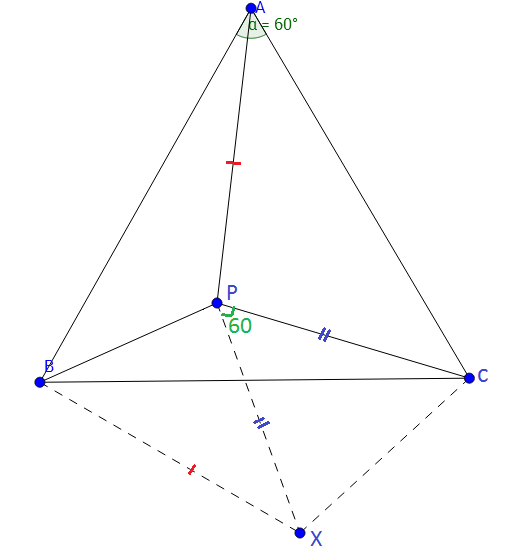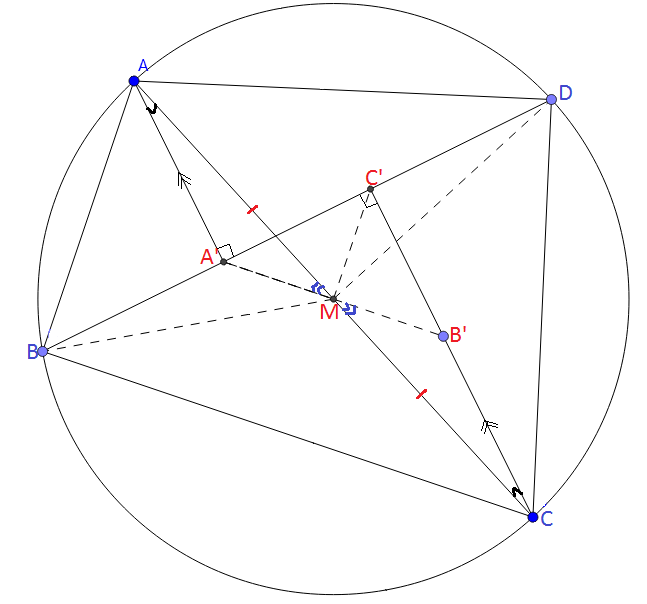RMO Board Part 2
Since the previous board was overcrowded with comments , I decided to create a new note so as to keep this step lively. If this also gets crowded , eventually we will again have new RMO board.What you have to do:
1) Propose a problem in the comments. Then I will add that problem here in this note content by giving the respective credit. And after I add the problem , the comment of proposing the problem must be deleted by the problem poster.
2) The problem poster must not post solution to his/her own problem unless someone from our community posts or no one gets it right even after considerable period of time.
3) Inappropriate / trivial comments are not allowed and must be deleted if posted by chance.An enthusiastic discussion is expected.
4) Please reshare this note so that we can reach most of the Brilliantians.
5)The problems to which solutions are posted will be accompanied by a checkmark at the end.
Problems:
Q1) Find all prime numbers for which there are integers satisfying and .
Q2) The roots of the equation form a non-constant arithmetic progression and the roots of the equation form a non-constant geometric progression. Given that are real numbers, find all positive integral values and .(Shared by Mycobacterium Tuberculae)
Q3) In an equilateral , is a point inside the triangle such that .Prove that .(Shared by Raven Herd)
Q4) Evaluate with respect to . (Shared by Svatejas)
Q5) Consider a cyclic quadrilateral such that is the diameter of its circumcircle. Construct points and on such that and . Show that .(Shared by Karthik V)
Q6) Prove that polynomial has at least one root in . (Shared by Shivamani P)
Q7) If are positive reals , determine the minimum value of the expression with proof. (Posed by Nihar M)
Q8)a) How many ways are there to represent a natural number as a sum of natural numbers?
Q8)b) How many ways are there to represent a natural number as a sum of non-negative numbers?
Q9) Find all ordered pairs of integers satisfying: .
Q10)a) Prove that if and both factorize into linear factors with integral coefficients, then the positive integers and are respectively the hypotenuse and area of a right angled triangle sides of integer lengths.
Q10)b) Show further that if where are integers, then are numerically the radii of the incircle and the three excircles of the triangle. (Shared by Svatejas S)
Easy Math Editor
This discussion board is a place to discuss our Daily Challenges and the math and science related to those challenges. Explanations are more than just a solution — they should explain the steps and thinking strategies that you used to obtain the solution. Comments should further the discussion of math and science.
When posting on Brilliant:
*italics*or_italics_**bold**or__bold__paragraph 1
paragraph 2
[example link](https://brilliant.org)> This is a quote# I indented these lines # 4 spaces, and now they show # up as a code block. print "hello world"\(...\)or\[...\]to ensure proper formatting.2 \times 32^{34}a_{i-1}\frac{2}{3}\sqrt{2}\sum_{i=1}^3\sin \theta\boxed{123}Comments
Q4) Let f(x)=(1+x)n=(0n)+(1n)x+…+(nn)xn
Now, f(1)+f(ω)+f(ω2)=(0n)(1+ω+ω2)+(1n)(1+ω2+ω4)+…+(nn)(1+ωn+ω2n) =3((0n)+(3n)+(6n)+…)
So, (0n)+(3n)+(6n)+…=3f(1)+f(ω)+f(ω2)=32n+(−ω2)n+(−ω)n.
So, we can manipulate the value of this expression by knowing the value of n.
Log in to reply
@Surya Prakash Great job!! Can you simply this further to eliminate ω?
Q1) It is clear that p(p−1)=2(y+x)(y−x). If p∣y−x it implies that p≤y−x, then it should imply that p−1≥2(y+x). But it is not possible. So, p does not divide y−x. So, p∣y+x it implies that p≤y+x, but this implies that p−1≥2(y−x). So, we get p+1≤4x. Which reduces to 2x2≤4x, x≤2. If x=1, then p=1, a contradiction. And x=2 implies that p=7. Therefore, p=7 is the only solution.
For the 2nd question,
Let the roots of first equation be m−d,m,m+d
Therefore we get that, m−d+m+m+d=3a=3m. Hence m=a
Then by applying Vieta's formula for other two, we get that, 3m2−d2=b and m3−md2=−18c
Let the roots for the second equation be n/r,n,nr
Therefore by applying Vieta's fomula,we get that, n=c and n(1/r+1+r)=−b and n2(1/r+1+r)=1
From here we get that, n=−1/b=c
Substituting these values in the previously acquired equations we get that, m3−m(3m2−b)=18/b
Simplifying we get that, ab2−2a3b−18=0
Applying formula for quadratic roots, b=aa3±a6+18a
For b to be an integer, a6+18a=k2
We see that, a3<k<a3+3
From here we see that, a=2 only satisfies. Therefore the required solutions are a=2 and b=9.
My solution for the 3rd one is quite big. I will just give some hints to solve it.
Try it by co-ordinate geometry.
Take B as (−1/2,0) and C as (1/2,0).Therefore,we get A as (3/2,0).
Then take P as(x,y) use the provided equation of PA2=PB2+PC2 to get the equation of locus of P.The equation comes out to be x2+y2+3y−1/4=0
Then take the X−Y plane as the Argand plane and apply the Rotation theorem of Complex numbers for B,P,C in order.Here the complex numbers are, i. B=−1/2, ii. C=1/2 and iii. P=x+iy
By simplifying the equation obtained in the 4th step, we get that ∠BPC=150∘
You may consider this as a solution because I have provided all the steps required.(But this step completely depends on you :P )
Log in to reply
Niceone: But Here is a still simpler one :)
Solution to 3rd stuff Construction: Draw PX = PC such that ∠CPX=60∘. Finally join BX and CX.
Construction: Draw PX = PC such that ∠CPX=60∘. Finally join BX and CX.
Clearly ΔCPX is equilateral. => CX = PC ------ 1 and Also, ∠PCX=∠ACB = 60∘ => ∠PCX−∠PCB=∠ACB−∠PCB => ∠BCX=∠ACP ------- 2
From the results in eqn 1, 2 and that BC = AC, we conclude that ΔBCX≅ΔACP. => BX = PA
But Given PB2+PC2 = PA2
=> PB2+PX2 = BX2 ............... [PC = PX and BX=PA]
Therefore by the converse of Pythagoras...theorem, it is obvious that ∠BPX = 90∘
Thus the required angle = ∠BPC = ∠BPX+∠CPX = 90∘ + 60∘ = 150∘.
1) p = 7
p(p−1)=2(y+x)(y−x)
comparing of y + x and p gives p = 7
Log in to reply
Sorry to say , but you have dropped out some cases. This solution is incomplete.
Log in to reply
let me check
p can't divide 2 and y - x so p divides only y + x and by some observations, i found x is equal to or smaller than 2, so when x = 1 then p = 1. No. then x = 2 so p = 7
Log in to reply
Include this in your previous comment and complete your solution. Don't make parts of your solution.
@Dev Sharma Kindly always post a full solution.
7) @Nihar Mahajan We have ab(a−c)+bc(b−a)+ca(c−b).
Multiplying we get a2b+b2c+c2a−3abc=abc(ca+ab+bc−3).
By AM-GM inequality, ca+ab+bc≥3.
Therefore, minimum value of the expression ca+ab+bc is 3.
Therefore, minimum value of ab(a−c)+bc(b−a)+ca(c−b) is 0 and equality occurs when a=b=c=0.
@Surya Prakash @Nihar Mahajan @Svatejas Shivakumar There seems to be a blunder in problem statement of Q4). I guess it meant " Simplify (0n)+(3n)+(6n)+(9n)+...(3⋅⌊3n⌋n)." The last summand being (nn) doesn't make sense at all if n is not a multiple of 3.
Log in to reply
Its correct.
Log in to reply
Try substituting n=4 in the summation. The link between last term of the summation ( i.e. last summand ) and previous summands is not clear.
Log in to reply
It satisfies.
Log in to reply
Let f(n)=(0n)+(3n)+(6n)+(9n)+...(nn).Then f(4)=(04)+(34)+(44) ? I am certainly sure about the last summand being (3⋅⌊3n⌋n), contrary to (nn) mentioned in the question.
Log in to reply
In that way!!!!! Then it is understood that it should be 3.[3n]
Log in to reply
I guess it would have been understood if it was just ..... , but rather it mentioned the last summand wrong 😓.
1) Solve y3=x3+8x2−6x+8 for positive integer x and y.
2) Two positive integer a and b such that aabb is divisible by 2000. What is least possible value of ab?
3) Find all real a for which x4−2ax2+x+a2−a has all real root
Hey Nihar plead post solution for question(9). Thanks!
Question5: Const: The constructions are clearly shown in the above diagram. Join BM, DM, C′M ,finally join A′M and produce it to meet CC′ at B′.
Const: The constructions are clearly shown in the above diagram. Join BM, DM, C′M ,finally join A′M and produce it to meet CC′ at B′.
AB is the diameter of the ⊙ABCD.
=> ∠ABC = ∠ADC = 90∘ => BM = DM [= 1/2AC ] => ∠MBC′ = ∠MDC′ --- 1
Clearly, ΔAA′M≅ΔCB′M => A′M = B′M => M is the midpoint of A′B′.
But ΔA′B′C′ is right angled at C′ and also M is the midpoint of A′B′. => C′M = A′M ---- 2
=> ∠MC′B = ∠MDA′ ----- 3
From the eqn 1, 2 and 3: ΔMC′B≅ΔMDA′ => BC′ = A′D.
K.I.P.K.I.G.
Would anyone help me in problem number 10
If x5−x3+x=η, the minimum value of x6 in terms of η.